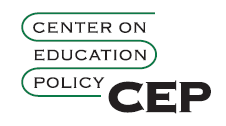

August 24, 2016
 In May, the Center on Education Policy (CEP) released Listen to Us: Teacher Views and Voices, a report that detailed the results of a national survey we administered to public school teachers late last year. The survey contained a broad set of questions designed to draw out the views and voices of teachers on timely issues in education such as standards and testing, but also on the profession overall. The goal was to produce a report that both reflected authentic teacher voices and provided useful and actionable feedback for policymakers and education leaders.
In May, the Center on Education Policy (CEP) released Listen to Us: Teacher Views and Voices, a report that detailed the results of a national survey we administered to public school teachers late last year. The survey contained a broad set of questions designed to draw out the views and voices of teachers on timely issues in education such as standards and testing, but also on the profession overall. The goal was to produce a report that both reflected authentic teacher voices and provided useful and actionable feedback for policymakers and education leaders.
Truth be told, conducting a national teacher survey can be tricky business. Like many issues in education, commentaries and analyses on teachers are often loaded with bias and judgment. Unfortunately, even the most thoughtful inquiries into teacher practice rarely generate concrete action.
Although Listen to Us elicited some fairly predictable answers about teaching (most come to the profession with altruistic intent; some are dissatisfied and would seek other employment if possible; the demands of teaching have become more complex and demanding), it also revealed how politics and the challenges of implementing reforms in a large, locally controlled system can create chaos for teachers and students.
For example, half of the teachers surveyed for this report said state and district policies that interfere with teaching and a constantly changing set of demands represent the biggest challenges in their profession. Considering the academic and social challenges that most teachers deal with on a daily basis, this data point is compelling. Instead of focusing on the very real challenges associated with the successful implementation of higher standards, teachers are instead dealing with the political folderol that has followed the Common Core and the new assessments around like an ominous storm cloud.
With the politics of education churning in the background, teachers are trying to focus on the very practical aspects of implementing new standards and assessments. The survey asked deliberate questions about teacher autonomy and the curricular materials being used to teach the standards. Most math and English language arts teachers said that, despite concerns that the standards would limit teacher autonomy, their classroom autonomy has remained the same or increased under the new standards. And while states and districts are providing many teachers with curricula for the standards, teachers are also making autonomous decision about developing and/or revising their own curricula.
The cautionary note here is that teacher autonomy could be a double-edged sword if teachers have to scramble to find high-quality curricula to teach the standards. If the access to and quality of curricula is wildly inconsistent, surely that will impact student achievement under the new standards. It seems to me the adage “the devil is in the details” has never been more apt. To provide all teachers with high-quality curricular materials that are aligned to the standards should be an essential part of implementation. Without that piece of the puzzle in place, any effort to raise the bar for all students will be hamstrung.
While a great majority of teachers feel students are spending too much time taking tests, some are trying to use the data from new assessments to modify classroom practice. In an effort to learn more about the complex issue of assessments, CEP also conducted in-depth focus groups with teachers regarding the new assessments. Those discussions did indicate that both accessing and understanding student test data from the new assessments remains a challenge. Once again, the details regarding how teachers are being supported to use the new assessments matter.
CEP’s new report is comprehensive and offers many other interesting data points and insights. We encourage you to visit www.cep-dc.org and check out the report, the executive summary, and other related resources.
A version of this blog post appeared on PDK’s blog, “Learning on the Edge.”